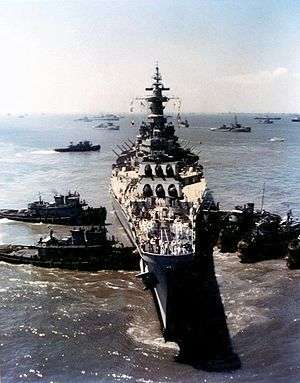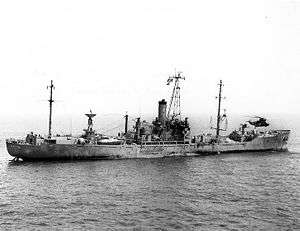USS Papago (ATF-160)
 USS Papago (ATF-160) c. 1954 | |
| History | |
|---|---|
| Builder: | Charleston Shipbuilding and Drydock Company |
| Laid down: | 19 March 1945 |
| Launched: | 21 June 1945 |
| Sponsored by: | Mrs. William Thomas Johnston |
| Commissioned: | 3 October 1945 |
| Decommissioned: | 28 July 1992 |
| Struck: | 14 February 1995 |
| Honours and awards: | |
| Fate: | Inactive Fleet - Philadelphia, PA |
| General characteristics | |
| Class and type: | Abnaki-class fleet ocean tug |
| Displacement: |
|
| Length: | 205 ft (62 m) |
| Beam: | 38 ft 6 in (11.73 m) |
| Draft: | 15 ft 6 in (4.72 m) |
| Propulsion: | Diesel-electric, four General Motors 12-278A diesel main engines driving four General Electric generators and three General Motors 3-268A auxiliary services engines, single screw |
| Speed: | 16.5 knots (30.6 km/h; 19.0 mph) |
| Complement: | 8 officers, 68 enlisted men |
| Armament: | One single 3"/50 gun mount, two twin-40mm gun mounts, two single 20mm guns |
USS Papago (ATF-160) was an Abnaki-class fleet ocean tug built for the United States Navy during World War II, and named for the American Indian tribe of the Piman family that formerly lived south and southeast of the Gila River in Arizona and the Mexican state of Sonora.
Construction history
Papago was laid down at Charleston, South Carolina by the Charleston Shipbuilding and Drydock Company on 19 March 1945. She was launched on 21 June 1945, with Mrs. William Thomas Johnston as her sponsor. Papago was commissioned into the United States Navy on 3 October 1945, with Lt. W. S. Hall in command.
Operational history
Post-shakedown operations
Following shakedown, Papago reported to the Naval Operating Base in Newport, Rhode Island on 17 November 1945 and conducted training operations and movements to assist various vessels in distress for the remainder of that year.
Major towing and salvage operations
- 1946–1950
After duty as a stand-by tug in Bermuda, Papago towed YD–171, the world's largest self-propelled Floating crane at the time, from Bremerhaven, Germany to Cristóbal, Colón, in the Panama Canal Zone, from 14 August to 20 September 1946.
Papago engaged in general towing, upkeep, and material maintenance for several months after which she made towing voyages in 1949 from the Panama Canal Zone to Naval Station Norfolk; from Norfolk to Newport; and from Boston to Bayonne, New Jersey.

From 30 January to 7 February 1950, Papago was involved in re-floating the battleship USS Missouri (BB-63), which had run aground in Hampton Roads on 17 January. She then moved decommissioned destroyer escorts to Philadelphia for the transfer to France under the Military Defense Assistance Program between 10 May to 14 May 1950.
- 1961–1962
Papago later towed the decommissioned heavy cruiser USS Des Moines (CA-134) from Boston to Philadelphia between 17 July to 21 July 1961. Papago was subsequently engaged in the salvaging and re-floating operation involving the decommissioned destroyer USS Monssen (DD-798), which had grounded at Beach Haven, New Jersey, while being towed by another vessel during a severe storm on 6 March 1962 between 6 March to 22 April. For this effort, Papago received a citation from Admiral Robert L. Dennison, the Commander-in-Chef U.S. Atlantic Fleet (CINCLANTFLT).
- 1968
The first half of 1968 was marked by four and a half months of almost continuous steaming in coastal and Caribbean waters involving the pioneering of nuclear submarine towing methods, followed in the fall by participation in communications experiments in the Virginia Capes area. Papago received the Award of Excellence in Engineering for fiscal year 1968.
- 1982
On 10 November, Papago towed the newly decommissioned destroyer USS Barry (DD-933) to the Naval Inactive Ship Maintenance Facility at the Philadelphia Naval Shipyard, reaching that facility on the 12 March.[1]
Naval exercises & operations
Papago did not participate in the Korean War, while she did perform towing operations in coastal waters and the Caribbean. Papago did participate in refresher training and towed gunnery targets in the Guantanamo Bay area from 11 March to 16 July 1957. She participated in NATO's Operation Strikeback, deploying to Scotland from 14 September to 28 September 1957. Papago also participated in NASA's manned space flight program as a naval support vessel for the following missions:
- Mercury Project - 2 December to 4 December 1959
- Gemini IX - 3 June 1966

Papago participated in quarantine operations during the Cuban Missile Crisis from 10 October to 14 November 1962. In early 1963, she provided services for Operation Springboard in the Caribbean Sea and spent much of the remainder of 1963 and 1964 in the Guantanamo Bay and Virginia Capes areas. Papago later joined Commander Task Group 124.3 (CTG 124.3) in May 1965 for duty during the crisis in the Dominican Republic, then steamed in the North Atlantic as part of Commander Service Division 81 (ComServDiv 81).
While serving as a rescue, salvage, and towing ship for the U.S. Sixth Fleet in 1967, Papago provided escort and communication support to the stricken USS Liberty (AGTR-5) which had been attacked by Israeli forces during the Six-Day War. Papago ended 1968 undergoing an extensive overhaul at Newport News.
Starting 28 June 1985, Papago participated in anti-drug patrols in the Caribbean Sea as part of Joint Task Force 4 (JTF-4).[2]
Awards & citations
Papago received the following awards and citations during her commission as a unit of the United States Navy:[3]
- Meritorious Unit Commendation
- Navy Battle "E" Ribbon (2)
- Navy Expeditionary Medal (3-Cuba)
- American Campaign Medal
- World War II Victory Medal
- National Defense Service Medal (2)
- Armed Forces Expeditionary Medal (1-Cuba, 1-Dominican Republic)
Disposal
Papago was decommissioned on 28 July 1992 and was struck from the Naval Registry on 14 February 1995. Ex-Papago was transferred to the Maritime Administration on 29 December 1997 for disposal, and is now a part of the Naval mothball fleet located in Philadelphia, PA.
References
- ↑ "USS Barry (DD 933)". Globalsecurity.org. Retrieved 2008-08-29.
- ↑ Polmar, Norman (2001). The Naval Institute Guide to the Ships and Aircraft of the U.S. Fleet, 15th edition. Annapolis: Naval Institute Press. pp. 24, 282. ISBN 1557506752.
- ↑ "USS Papago (ATF-160)". Navsource.org. Retrieved 2008-08-29.
- This article incorporates text from the public domain Dictionary of American Naval Fighting Ships. The entry can be found here.
- This article includes information collected from the Naval Vessel Register, which, as a U.S. government publication, is in the public domain. The entry can be found here.
- Photo gallery of USS Papago at NavSource Naval History